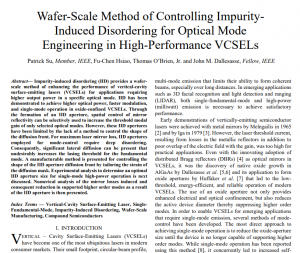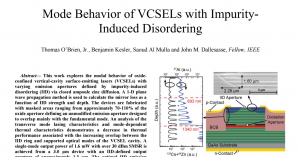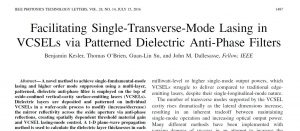
The Advanced Semiconductor Device and Integration Group is proud to share a recent publication by Kanuo Chen, Fu-Chen (Alex) Hsiao, Brittany Joy, and Professor Dallesasse on demonstrating the ability to control radiative base recombination in a quantum-cascade light emitting transistor that shows performance benefits of a transistor-injected QCL over conventional QCL devices.
Applied Physics B Article Link

The Advanced Semiconductor Device and Integration Group is proud to share a recent publication by Tommy O’Brien, Ben Kesler, Sam Almulla and Professor Dallesasse exploring the modal behavior of oxide-confined vertical-cavity surface-emitting lasers (VCSELs) with varying emission apertures defined by impurity-induced disordering (IID) via closed ampoule zinc diffusion.
Click Here for Full Article in IEEE Photonic Technology Letters

This work explores the modal behavior of oxide-confined vertical-cavity surface-emitting lasers (VCSELs) with varying emission apertures defined by impurity-induced disordering (IID) via closed ampoule zinc diffusion. A 1-D plane wave propagation method is used to calculate the mirror loss as a function of IID strength and depth. The devices are fabricated with masked areas ranging from approximately 70-110% of the oxide aperture defining an unmodified emission aperture designed to overlap mainly with the fundamental mode. An analysis of the transverse mode lasing characteristics and mode-dependent thermal characteristics demonstrates a decrease in thermal performance associated with the increasing overlap between the IID ring and supported optical modes of the VCSEL cavity. A single-mode output power of 1.6 mW with over 30 dBm SMSR is achieved from a 3.0 μm device with an IID-defined output aperture of approximately 1.3 μm. The optimal IID emission aperture to oxide aperture ratio for maximizing the single-fundamental-mode output power is experimentally measured.
SINGLE-TRANSVERSE-MODE VCSELS VIA PATTERNED DIELECTRIC ANTI-PHASE FILTERS
A novel method to achieve single-fundamental-mode lasing and higher order mode suppresion using a multi-layer, patterned, dielectric anti-phase filter is employed on the top of oxide-confined vertical-cavity surface-emtting lasers (VCSELs).
Click here for Full Article in IEEE Photonics Technology Letters

